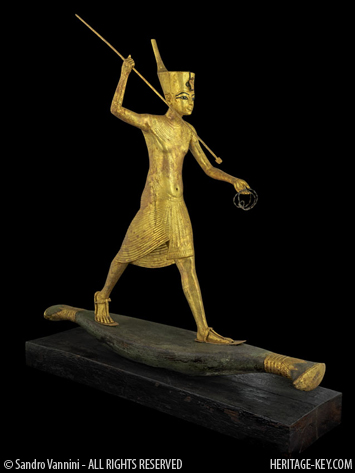 A team of archaeologists, led by Professor Vance Watrous and Matt Buell of the University at Buffalo, have discovered a fortification system at the Minoan town of Gournia.
A team of archaeologists, led by Professor Vance Watrous and Matt Buell of the University at Buffalo, have discovered a fortification system at the Minoan town of Gournia.
The discovery rebukes the popular myth that the Minoans were a peaceful society with no need for defensive structures. That idea arose from work done in the early 20th century by Sir Arthur Evans who proposed that a pax Minoica existed on Crete during their time. Certainly the Minoans were afraid of somebody, Professor Watrous said.
The town was originally excavated from 1901-1904 by Harriet Boyd Hawes, a pioneering women who was among the first to excavate a Minoan settlement. Located on the north coast, Gournia was in use during the neo-palatial period (ca. 1700-1450 BC), a time when Minoan civilization was thriving. It had about 60 houses with a small palace in the centre. The houses are tightly packed together Buell said, adding that archaeologists have uncovered evidence for wine making, bronze-working and stone-working at the site. The town also had a shipshed, used for vessels. It was at least 25 meters north-south and 10 meters east-west.
Experience a Classical Aegean Town
 Gournia gives you, the visitor, a real feeling of what an Aegean town was actually like. Walking up the streets, past the houses, you feel like youve been transported into the past, said Buell.
Gournia gives you, the visitor, a real feeling of what an Aegean town was actually like. Walking up the streets, past the houses, you feel like youve been transported into the past, said Buell.
The fortification system that the team uncovered was built to prevent people from attacking the town by landing on the beach.
The townsits atop a low ridge with four promontories on its coastline. Two of these promontories end in high vertical cliffs that would be tough going for an invader. The other two promontories slope gently down to the shore, said Professor Watrous. They would have provided easy access to the town. It was on these two promontories that the Minoans built structures.
The fortification system was discovered by means of drawing, photography and survey. Archaeologists did not have permission to excavate so they could not actually dig it up from the ground. They did have to clear away a lot of brush that was obscuring the remains on the surface.
The Fortifications
 The eastern-most promontory had a heavy wall that was about 27 meters long. Beside it the team found a semi-circular platform of stone, almost nine meters in diameter this is likely the remains of a tower or bastion.
The eastern-most promontory had a heavy wall that was about 27 meters long. Beside it the team found a semi-circular platform of stone, almost nine meters in diameter this is likely the remains of a tower or bastion.
Its difficult to say how high the tower was. Professor Watrous suggested, from the size of the base, that it was at least six feet high and maybe higher. The other fortified promontory had a two meter thick wall, running east-west, as if to close off access from the sea, he said.
In addition to the beach fortifications, it also appears that the Minoans built a second line of defence a little bit inland. Heading south, away from the beach, there were two walls, together running about 180 meters east to west. Backed by a tower, or bastion, they encompassed natural features such as a hedge. The walls would have posed a formidable challenge to any invader trying to march south towards the town.
The Defenders
Defenders manning this system of fortification would have rained projectiles down on attackers, by using bows and slings. The walls had stone foundations and were made of mud brick, making them sturdy enough to stand on.
Its an open question as to whether the people guarding the fortifications were part of a militia or something more organized. There was definitely a body of men who would have had that duty but we dont know exactly what they were like, said Professor Watrous.
Tombs uncovered by Hawes and other excavators have shown people buried with swords. Watrous said that there was one particular tomb that produced an entire collection of daggers, swords and other items, adding: Hawes said that she thought he was some sort of military personnel.
Gournia’s End
The sad story of Gournias fortifications is that they did not prevent the towns demise. Gournia fell around 1450 BC, the same time as other Minoan settlements. A new group called the Mycenaean appeared on Crete at this time, taking over the island.
 Its likely that they avoided attacking the town by sea. “Many other settlements were destroyed at the same time. My guess is that they just came along the land; they didnt have to come up from the sea, said Professor Watrous.
Its likely that they avoided attacking the town by sea. “Many other settlements were destroyed at the same time. My guess is that they just came along the land; they didnt have to come up from the sea, said Professor Watrous.
He cannot say for sure if the town defences were ever actually put to their intended use. Any evidence of a battle near these fortifications, such as weapons or bodies, would be underground, and excavation would have to be carried out to see if they exist.
One thing that excavators can say is that the people of Gournia had something worth fighting for. Many of the goods they made such as the wine and the bronze implements – were for export, suggesting that the people had some level of wealth.




